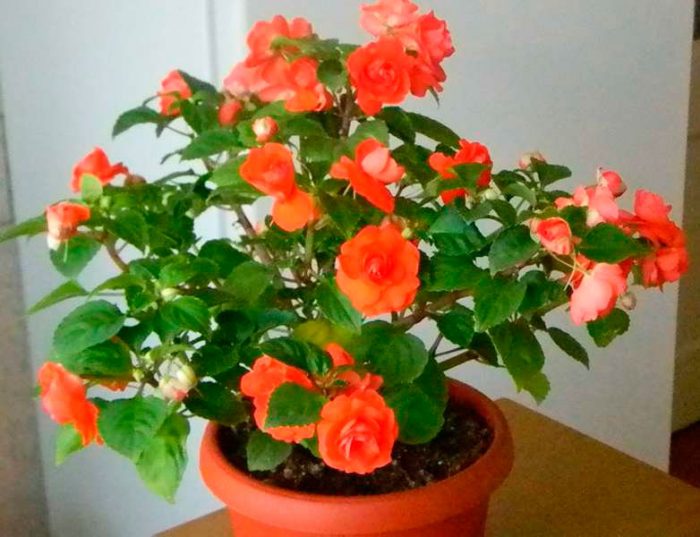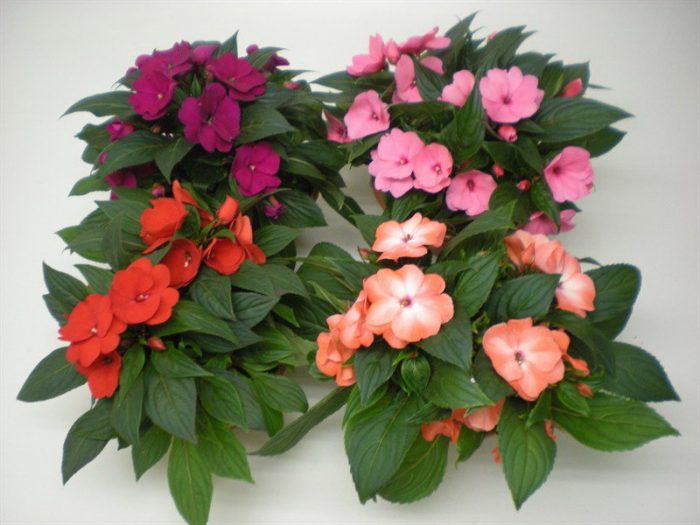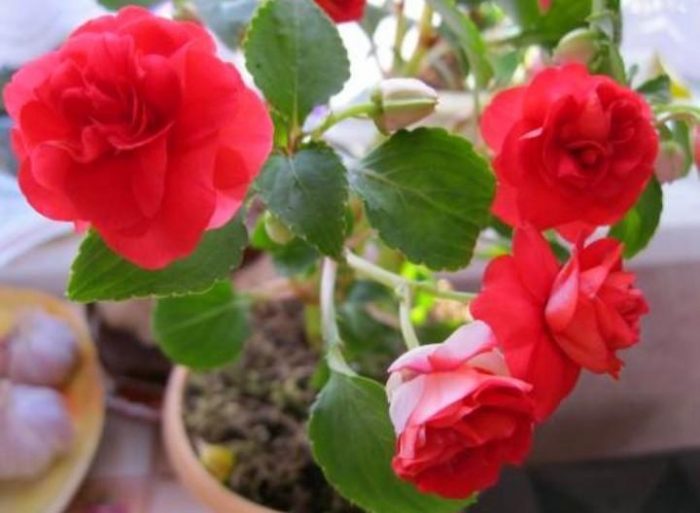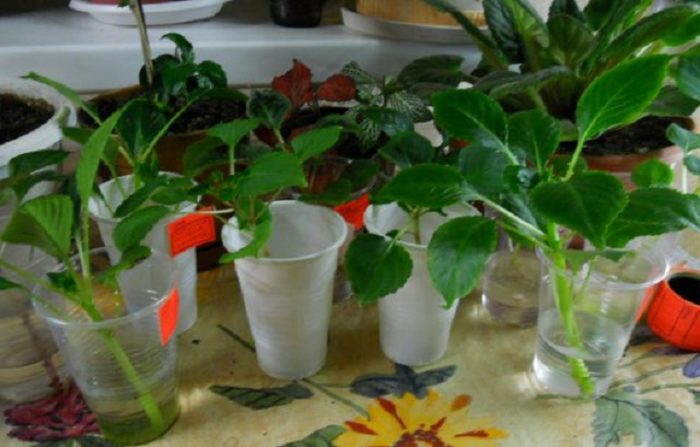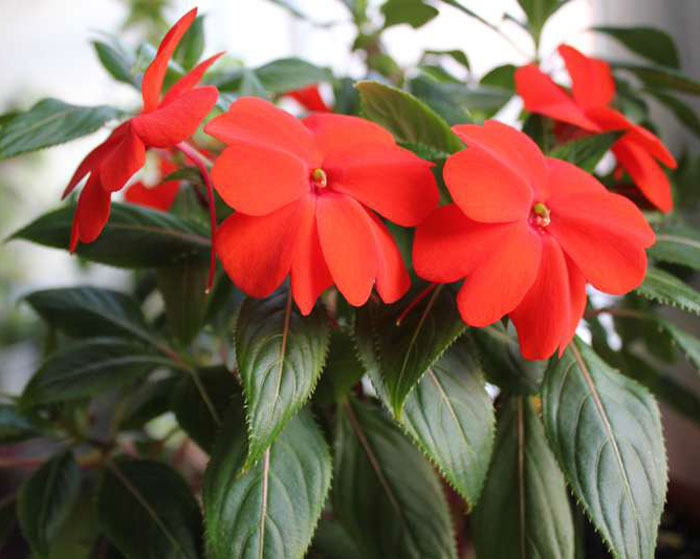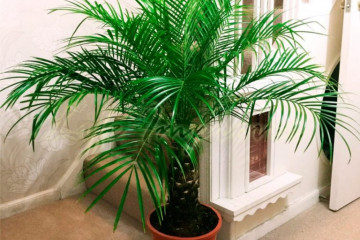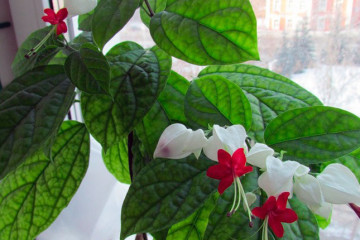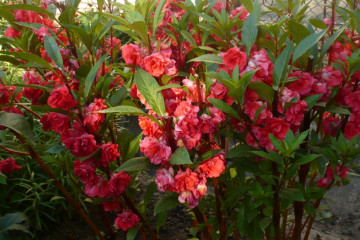Balsam room - home care
Content:
Many people associate balsam with childhood, with their grandmother's house, where this unpretentious flower always flaunted on the windows next to geraniums. By the way, the plant has more than one name, there are others: "wet Vanka" (as people began to call the plant due to its ability to form drops of liquid on the leaves at high humidity), "touchy", "light".
Balsam remains a popular home flower even now, and this is well deserved - it does not require special growing conditions, is not capricious in its care and has a long flowering. In addition, not only its bright flowers are attractive, but also juicy, bright leaves.
Room balsam: general information
This plant is represented by a large variety of varieties that differ in size, shape and color. The plant can grow in height from 15-20 to 45-50 cm. The leaf of this popular flower has wavy edges and is quite fleshy, its color ranges from rich green to red-green and bronze.
The flowers of the plant are located in the axils, and their color can be so varied that there are all sorts of shades of red, pink, purple, orange. Also, new varieties with spots and stripes on flowers, with leaves of different colors, varieties with double flowers have been bred. Therefore, in all this diversity, it is very easy to get confused, choosing a balsam for yourself.
In place of flowers that have bloomed, green boxes are formed, inside which seeds ripen. A feature of such boxes, thanks to which the plant is popularly called touch-sensitive, is their ability to burst and scatter seeds at the slightest touch to them.
Balsam is found in perennial varieties that are grown indoors. There are also annual varieties that feel great on balconies, in pots, in flower beds. Usually these varieties are adapted to lower temperatures and bloom from spring to autumn. So this cutie will definitely be able to decorate your home.
Any flower lover will figure out how to care for balsam. One has only to adhere to the basic simple rules, and the plant will thank you with lush and colorful flowering.
How to plant balsam after purchase
Like any other newly acquired plant, a touchy one needs 2-3 weeks to adapt to a new place. Therefore, during this period, the plant is treated normally. But after a few weeks, the balsam can be planted in a new pot.
Balsam is carefully removed from the old pot so as not to damage fragile shoots (it will need to be watered a day before transplanting), dried and damaged roots are removed (the cuts are processed with crushed coal) and quickly, so that the roots are not too weathered, balsam is planted into a new pot, filling it with fresh soil. During transplantation, the root collar should not be deepened too much.
For touch-sensitives, the soil for flowering plants is perfect, the main thing is that it is loose. When planting, be sure to remember about drainage, so a layer of drainage material should be placed on the bottom of the pot (expanded clay is perfect).
For a plant, it is better to choose slightly shaded places, since the plant does not tolerate a long stay in direct sunlight. Therefore, balsam grown as a houseplant on the balcony (if it is not too open) will feel just fine in the summer.
Reproduction of indoor balsam
This plant is capable of excellent propagation using cuttings or seeds.
Propagation by cuttings
For the cuttings, the apical shoots are chosen, which are cut into about 9-10 cm in size. Further, for rooting, which occurs quite quickly in balsam, within a few days, it is enough to either place the cuttings in water or plant them in moist soil mixed with sand.
After the shoots have sprouted, they should be planted in separate small pots, and after a few months color will appear on them.
Another feature of balsam is that the plants that grow from the cuttings are not transplanted. The thing is that in the process of long flowering, the shoots stretch out, lose the lower leaves, and by autumn it will be much more effective to renew them using cuttings.
Balsam from seeds - growing at home
The balsam plant can also be propagated without problems using seeds.
For this, the seeds are planted in a greenhouse or greenhouse around the end of winter or early spring. You must try to sow each seed separately. If you provide the crops with the required temperature regime (about 24-25 degrees), then the first sprouts will appear in about a month. After that, the greenhouse can be slowly opened.
And when several leaves appear on the sprouts, they need to be dived into separate containers.
Balsam room: home care
The rules for caring for the plant are quite simple, but they must be adhered to, since otherwise the leaves may fall off. It is the non-observance of the rules of care that leads to questions why the balsam does not bloom or why it begins to fall off and shed unblown buds.
Lighting
For a wet Vanka, both good lighting and partial shade are suitable. But if you want to achieve a fairly long and lush bloom, bright lighting for at least a couple of hours a day is very important. But prolonged exposure to direct sunlight is still best avoided. This also applies to indoor plants and outdoor varieties.
For the latter, when planting, you should choose places with partial shade, and for some varieties, shade is needed at all. In too open places, only one variety is capable of developing perfectly: New Guinea balsam (caring for it in the garden is otherwise no different).
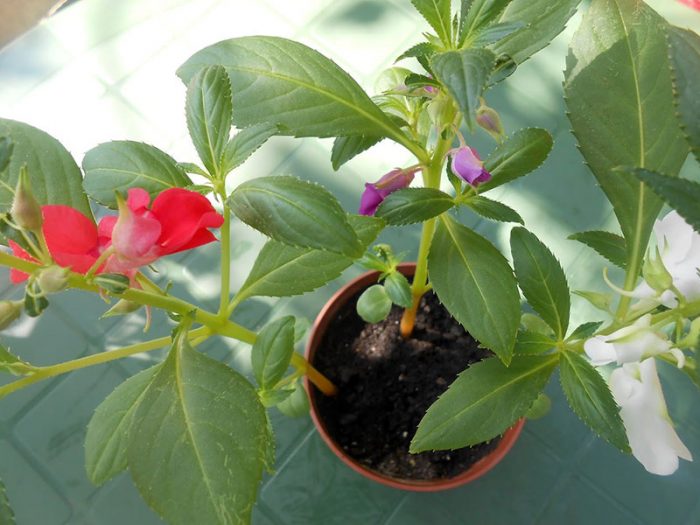
Avoid prolonged exposure to direct sunlight - this will negatively affect the appearance of the plant
Watering
Impatiens are water lovers.
If watering is carried out in insufficient volume, then the stems will begin to lose their elasticity, and the plant will begin to shed the lower leaves.
- In the summer, balsam is watered often and abundantly, making sure that the soil is always moist.
- In winter, watering is reduced, but the substrate should not be allowed to dry out.
Also, do not allow the liquid to stagnate in the sump or in the substrate - this can cause rot.
Top dressing
Balsam needs fertilization in spring and summer, when the plant is most active.
For this purpose, ordinary fertilizers for flowering plants are used, but you should not get carried away with them - it will be enough to apply them once every 2-3 weeks, since an excessive accumulation of nitrogen will lead to the fact that the balsam will bloom much worse and will simply begin to increase the green mass.
Caring for balsam during flowering and dormancy
During flowering, wet Vanka does not require special care. The only limitation during this period: it is better not to irrigate the plant from the sprayer or to carry it out very carefully so that moisture does not get on the flowers.
You should also avoid overgrowing the shoots. To do this, they should pinch the top, due to which lateral shoots begin to develop more actively, and the formation of a plant allows a more lush bush to grow. Too elongated shoots are cut off (they can be used for cuttings) - spring is best suited for this procedure.
During the dormant period, when winter comes, watering is gradually reduced to balsam.
Diseases and pests
Unfortunately, the weak side of this plant is its tendency to various diseases and susceptibility to damage by some pests. Therefore, the flower should be examined as often as possible and, when the first symptoms appear, immediately take action, since it may die.
Of the pests, balsam most often affects the spider mite and whitefly. They attack the plant due to violation of the conditions of detention:
- excessive dryness of the air and earthen coma,
- too high air temperature,
- lack of air ventilation.
With excessive watering, balsam often infects a disease: rot and fungal diseases. In this case, it is urgently needed to transplant it into a new pot with a new substrate and a good drainage layer.
The appearance of black spots on the leaves of the plant indicates the development of bacteriosis. In this case, balsam should be treated with special preparations (for example, Alirin).
Balsam is a lush and long-flowering plant. Thanks to breeding work, a huge number of varieties and varieties of flowers have been bred, which differ from each other in shape, size, color of flowers and leaves. The plant is unpretentious in care and does not require special conditions of maintenance, so even a beginner in floriculture can grow it.

